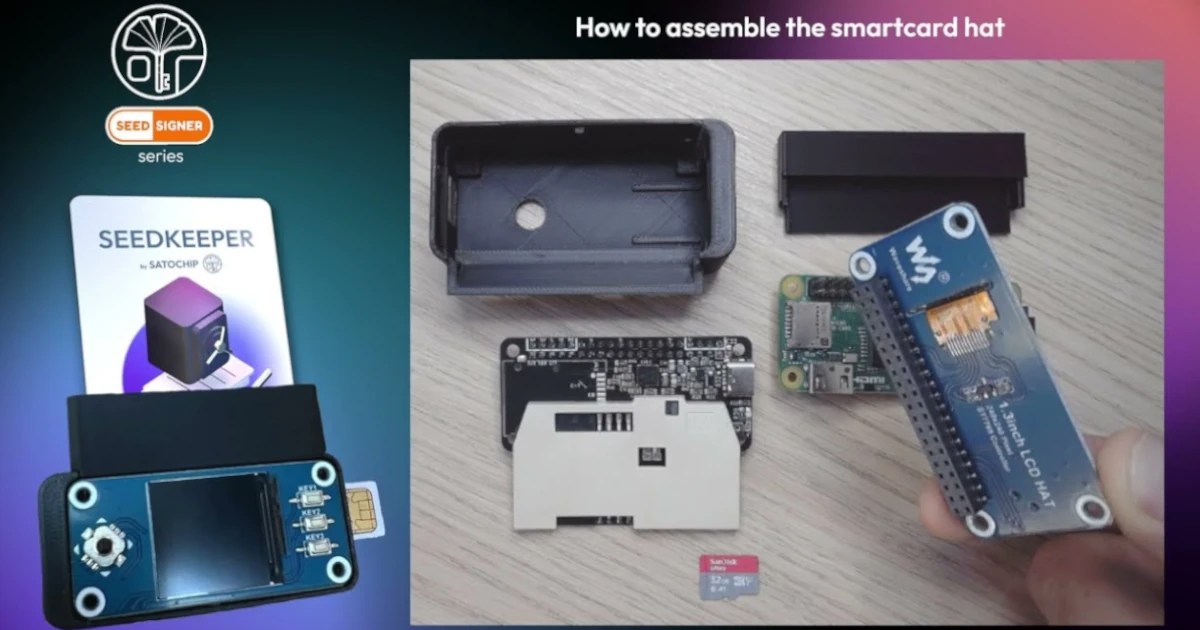Did you know you can build your own hardware wallet? I recently attended a workshop with Dani @bitcoineando, a Bitcoin evangelist and software engineer who will be hosting a workshop on this very topic next week in Adopting Bitcoin, El Salvador.
For those attending the historic Adopting Bitcoin conference happening later this month in El Salvador, there’s an exciting free workshop scheduled for Friday, November 14th, from 3:50 to 4:50 pm. It will be held in the English Workshop room and will be conducted in both English and Spanish. Attendees who bring a laptop and participate in the full workshop will receive a free Seedsigner + Satochip combo to take home — along with the knowledge to build the entire setup themselves.
Sign up now to secure a limited spot!
What’s truly remarkable about these two open-source projects is that they are made of widely available hardware components that can be purchased almost anywhere in the world.
**SeedSigner**
The SeedSigner project was launched in December 2020 with the goal of empowering users to build an affordable, air-gapped Bitcoin transaction signing device for around $50. It utilizes off-the-shelf hardware such as the Raspberry Pi Zero v1.3, a camera module for QR code scanning, and a small LCD display for transaction verification and menu navigation, operated via a tiny joystick and three buttons.
SeedSigner is fully open source, released under the MIT license, meaning all software, hardware specs, and enclosure designs are publicly accessible on GitHub. This transparency allows anyone to verify, modify, or build from the source code for community-driven improvements.
While the Raspberry Pi Zero’s firmware and bootloader are proprietary from Broadcom, the SeedSigner design manages those risks by allowing users to provide their own entropy and by avoiding wireless modules like Bluetooth. It is designed to be stateless, booting fresh each time without retained memory, requiring the user to input the seed for signing transactions in each session. These security measures make SeedSigner a popular choice among enthusiasts and advanced users, though its setup process can be more tedious and user-experience challenging compared to traditional hardware wallets.
**Satochip**
Founded in Belgium in 2014 by Baudouin Collard and Bastien Taquet, Satochip focuses on affordable, open-source smartcard-centric hardware wallets. Their flagship product, the Satochip NFC wallet, along with the Satodime (a bearer card) and Seedkeeper (a password manager), work with popular wallets like Sparrow and Electrum.
Satochip’s Java Cards project is an open-source applet that enables inexpensive smartcards—such as YubiKeys or SIM cards—to function as secure, DIY BIP39 hardware wallets with EAL6+ security. Using stateful smartcards, these devices securely store key material in encrypted formats with advanced security chips, often surpassing the security standards of bank cards.
These NFC-enabled smartcards communicate via near-field communication technology, which offers limited range—considered a security advantage. Many high-grade hardware wallets, like CoinKite’s Coldcard Q, incorporate NFC technology for enhanced security.
However, a key limitation of smartcards is the absence of a screen for transaction verification. To overcome this, Satochip integrates with various mobile and desktop applications, including dedicated Android and iOS apps. Notably, SeedSigner has developed a community-driven fork of its firmware that allows users to flash Satochip smartcards directly from SeedSigner, streamlining the setup process and supporting an expansion of smartcard reader hardware.
This combined approach of SeedSigner and Satochip creates a powerful, open-source ecosystem that leverages common hardware components, enhancing both security and user experience. It offers a flexible, accessible way for users to create their own secure Bitcoin wallets.
**Security and Verification**
A crucial part of the workshop, website, and how-to guides focus on verifying the authenticity of the software used on these devices. Both SeedSigner and Satochip applets are signed using PGP keys by their developers. To verify authenticity, a cryptographic hash (like SHA-256) of the software is generated, producing a unique string of digits that represents the exact code. If any part of the software changes, the hash will also change.
This hash is then signed by the developer’s PGP key, creating a chain of signatures. This process assures users that the software they are installing is legitimate and from a reputable source. Learning how to perform these verifications might seem intimidating at first, but it’s a straightforward process that embodies the core cypherpunk principles of sovereignty and trustlessness in the digital age.
—
By participating in this workshop, you’ll gain not only the technical skills to build and verify your own hardware wallet but also a deeper understanding of the importance of software authenticity in safeguarding your digital assets.
https://bitcoinethereumnews.com/tech/build-your-own-hardware-wallet-seedsigner-satochip-combo-is-nuts/



